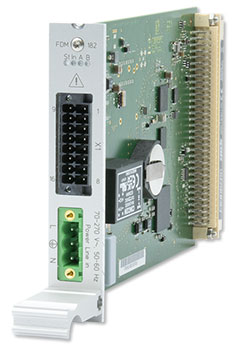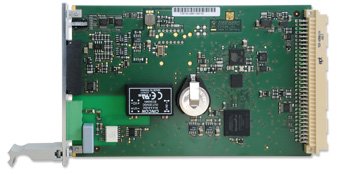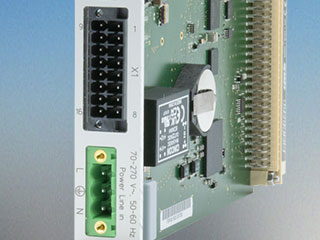IMS-FDM: Frequency Deviation Monitor for 50/60 Hz power line networks
Key Features


- Monitoring of Mains Frequency
- 2 analog outputs (time deviation and/or frequency deviation)
- IMS module FDM-LVI - Low Voltage Input (3 - 9 V AC)
- Serial RS-232 Interface
- Calculation of Time based on the Local Frequency
Product Description
How It Works
The host reference clock of the IMS system provides a serial time string and a pulse-per-second signal. These signals are critical to the accuracy of the measurements and provide the basis for the accurate reference time. When the FDM module is (re)started, the power line time is also synchronized with the reference time, so that the time deviation is also zero at this point.The reference time from this point continues to be synchronized on the basis of the signals from the reference clock, while the power line time is maintained solely on the basis of the mains frequency. For example, if the IMS-FDM is configured to expect a 50 Hz grid frequency, for example, one second of the power line time is equivalent to 50 oscillations of the input voltage.
If the power line frequency drops to 49.5 Hz for exactly one second, one second will pass in the power time line while 1010 milliseconds have passed in the reference time; one second in the reference time scale remains exactly 1000 milliseconds. This results in a drift of +10 milliseconds. If the same frequency deviation persists for another second, the drift increases to +20 milliseconds. This drift (time deviation) therefore provides a direct measure of frequency instability over time.
FDM-LVI - Low Voltage Input
The IMS module FDM-LVI is available for low input voltages. The input voltage here is 3 - 9 V AC (50 - 60 Hz).
Characteristics
| Input signal | 10 MHz, serial time string, PPS (via backplane) mains frequency, 70 - 270 V AC, 50 Hz or 60 Hz |
| Interface | Two asynchronous serial RS-232 ports, COM0 and COM1 via 16pin DMC connector
Baudrate: 1200, 2400, 4800, 9600, 19200, 38400, 57600, 115200 Baud Framing: 7N2, 7E1, 7E2, 8N1, 8N2, 8E1, 7O1, 8O1 Mode: Per Second, per Minute, on Request Output string: The frequency, frequency deviation, reference time, power line time and the time deviation are send out in different available formats - adjustable via web interface:
|
| Resolution of Measurement | frequency: accuracy of the oscillator (10MHz) ±100µHz time deviation: accuracy of reference (PPS) ±1ms |
| Analog outputs | 2 analog outputs for longtime-recording via 16pin DMC connector (time deviation and/or frequency deviation),
range: -2.5 V ... +2.5 V, resolution: 16-bit (65536 increments) |
| Operating Voltage | +5 V DC |
| Current Draw | 0.4 A - 1 A |
| Board type | Eurocard |
| Board Dimensions | 160 mm x 100 mm, 1,5 mm Epoxy |
| Supported Temperature | Operational: 0 - 50 °C (32 - 122 °F)
Storage: -20 - 70 °C (-4 - 158 °F) |
| Supported Humidity | Max. 85 % (non-condensing) at 40 °C |
| Warranty | Three-year warranty |
| RoHS Status of Product | This product is fully RoHS-compliant. |
| WEEE Status of Product | This product is handled as a B2B (Business to Business) category product. To ensure that the product is disposed of in a WEEE-compliant fashion, it can be returned to the manufacturer. Any transportation expenses for returning this product (at end-of-life) must be covered by the end user, while Meinberg will bear the costs for the waste disposal itself. |
Downloads
Short Info Sheet
Manuals
- For drivers, SDKs, tools and utilities, please check our Download Section





